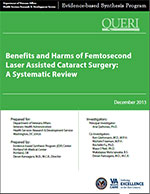
|
Principal Investigator: Evidence-based Synthesis Program (ESP) Center, Portland VA Medical Center,
Portland, OR
Washington (DC): Department of Veterans Affairs; December 2013 |
Download PDF: Complete Report, Executive Summary, Report, Appendices
The preferred method of removing cataracts in the developed world is phacoemulsification. Using this technique, ultrasonic energy softens the dense lens material of the cataract, which is then extracted from the eye with suction and irrigation. Current practice includes creating manual corneal incisions and anterior capsulotomies, followed by phacoemulsification. Recently these three manual procedures have been performed in an automated fashion with the use of the femtosecond laser (FSL). Several FSL systems have been approved by the FDA for use in the U.S. for some or all of these procedural steps in cataract surgery. FSL technology has been widely used in various refractive surgery applications in recent years. Studies have suggested decreased phacoemulsification energy use with FSL cataract surgery and have examined the potential advantages of more precise corneal incisions and capsulotomy formation.
Cataract surgery is a frequently performed operation in the VHA, with more than 49,000 performed in 2012. As a result, the VHA National Surgery Office has been tasked with making a recommendation regarding whether femtosecond lasers provide appropriate cost-benefit and risk-benefit ratios to support implementation for cataract surgery in the VA. The purpose of this systematic review is to examine the effectiveness and safety of femtosecond laser assisted cataract surgery (FLACS) relative to conventional cataract surgery. Key questions were developed in conjunction with the stakeholders which address the effectiveness, safety, adverse consequences and economic implications of adopting FLACS into the VA system.